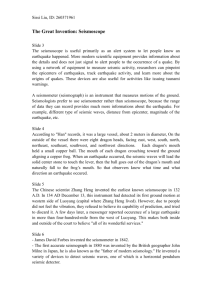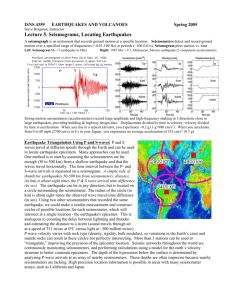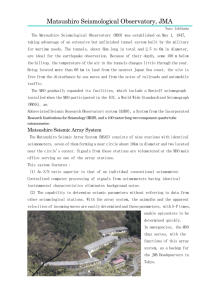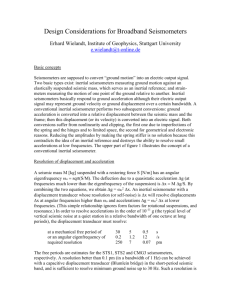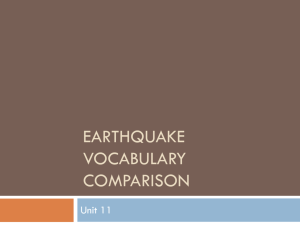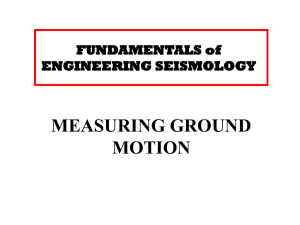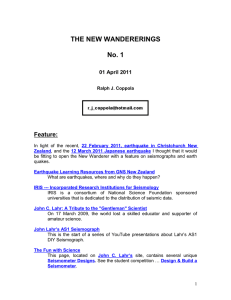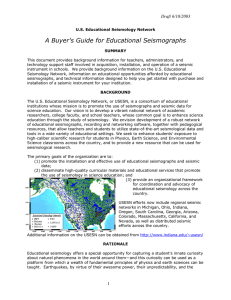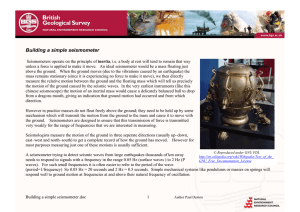lecture13_2012
advertisement
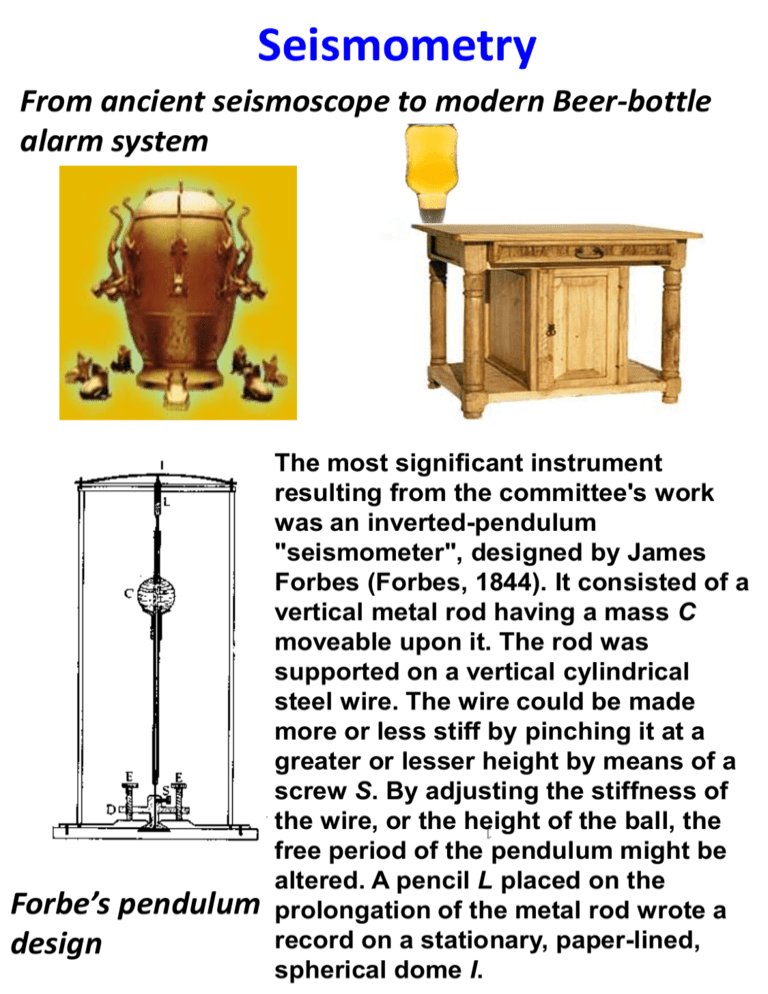
Seismometry From ancient seismoscope to modern Beer-bottle alarm system The most significant instrument resulting from the committee's work was an inverted-pendulum "seismometer", designed by James Forbes (Forbes, 1844). It consisted of a vertical metal rod having a mass C moveable upon it. The rod was supported on a vertical cylindrical steel wire. The wire could be made more or less stiff by pinching it at a greater or lesser height by means of a screw S. By adjusting the stiffness of the wire, or the height of the ball, the free period of the pendulum might be altered. A pencil L placed on the prolongation of the metal rod wrote a record on a stationary, paper-lined, spherical dome I. 1 Forbe’s pendulum design Mallet’s design Explosion seismology was born in 1851, when Robert Mallet used dynamite explosions to measure the speed of elastic waves in surface rocks (rock physicist!). He wished to obtain approximate values for the velocities with which earthquake waves were likely to travel. To detect the waves from the explosions, Mallet looked through an eleven-power magnifier at the image of a cross-hairs reflected in the surface of mercury in a container. A slight shaking caused the image to blur or disappear. 2 Record from a Cecchi seismograph Filippo Cecchi's instrument has been described by later Italian seismologists as the first true seismograph. The machine was apparently built in 1875. Unlike any of the instruments we have discussed so far, the Cecchi seismograph was expected to record the relative motion of a pendulum and the Earth as a function of time. For horizontal vibrations, two common pendulums were used, one vibrating in a north-south plane and the other vibrating in an east-west plane. Another group that got a lot of credit for observation seismology is a group of British professors teaching in Japan in the late nineteenth century. These scientists obtained the first known records of ground motion as a function of time. The most famous ones are John Milne Jame Ewing Milne is often cited as father of seismograph 3 James Ewing’s Horizontal Seismograph N A cylindrical mass is attached to two levers (top and bottom) and the levels are in turn attached to a long thick rod that has a needle at the left end N. Any small horizontal movement of mass will be translated to a rotation of the long rod, which uses the needle to scratch a large, curved painted glass. Two of such devices can give two components of movements, NS and EW. Ewing Medal is a top 3 American Geophysical Union Award. Sample records from Ewing Seismograph 4 You get the idea. The older seismographs tried to mechanical devices to amplify the ground motion, usually requires a long rod of some sort. In a nutshell… Modern seismographs record the relative motion between the pendulum and frame and produce an electrical signal that is magnified electronically thousands and even hundreds and thousands of times before it is used to drive an electric stylus, or to be recorded to a computer hardrive producing the resulting seismogram. These electrical (voltage) signals produced by the responses of the inertial mass to the ground motion are passed through lownoise electronic circuits that act as filters. These filters are set to pass through only those waves in5 the frequency range of scientific interest. Albuquerque Seismological Laboratory Cite of IRIS Passcal Center (center for IRIS temporary deployments) WWSSN (World-wide Standardized Seismic Network) Started around 1960 and completed in 1971, consisting of 120 continuous (not digital), 3 – component seismographs (generally short-period instruments). Around 1971, long-period (1-25 sec) instruments are deployed and the digital age truly arrives. The new network was termed Global Digital Seismic Netowrk (GDSN), the predecessor of GSN as we know it today. . Global Seismic Network 3-component, broadband, global seismic network. The number of stations grows to 160 or more, but the speed of increase has slown down. Reason: Modeling strategy change. Global analysis of seismic structure is moving to a new direction ----- Regional Seismic Networks monitored by individual countries but with connections (e.g., data exchange) with IRIS Never again let a man do a machine’s job in Geophys 624. This is inevitability, Mr. Gu! Thanks. Deployment then vs. now. Differences: Greater instrument quality, larger storage, better timing with GPS, better vault insulation and noise reduction (though this quite arguable as many of the old vaults are still being used), telemetry. New Phase of Earthquake Analysis: Regional Arrays Below: USArray deployent (>400 temporary stations). The schedule is changing every two years, moving to the east one patch at a time every two years. As part of EarthScope Project, the 11 Instrument Reponses Broadband vs. WWSSN seismometers These are the response curves (meaning filtered due to the individual electronic units at a given seismic station). The WWSSN network was installed before the early 1980s, but now most instruments are broadband that incorporate good responses at both short and long periods. 12 Temporary Deployments Seismometers are buried for best signal-noise ratios. The vault could be a big bucket. Concrete flooring is poured to the bottom (connected to soil) to improve leveling. Also a tile is fixed to the concrete floor. Seismometer Vault Alberta CRANE network (UofA) Thermal insulations are added to reduce temperature effect. Then vault is closed (only a cable is extended outward to connect to digitizer. 13 Set up at CRANE stations in Alberta More fancy types After deployment Before deployment Ocean Bottom Seismometers (OBS) Ocean Bottom Seismometers (OBS) Release transducer digitizer hydrophone disk Upper sphere sensor battery Lower sphere anchor 16 Instrument Response Z-transform A time series is a collection of data sampled at even intervals. The Z-transform of the the time series xn ( n 0, 1, 2, ...) can be represented by a polynomial in z. X(z) x z n for n > 0 : delay or n < 0 : advance n n Example: 1. Let x be a causal time series t0 t1 t2 t3 n 0 1 2 3 x 4 5 -1 -3 Z-transform is X(z)=4z0+5z1-z2-3z3 (z is continuous complex) 2. Let x be a non-causal time series (Q infested) t1 t2 t3 t-3 t-2 t-1 t0 1 2 3 n -3 -2 -1 0 x -1 Z-transform is 3 4 3 5 6 -10 Sometime an arrow is used to show t=0 17 3 -3 -2 -1 0 1 2 X(z)=-1z +3 z +4z +3z +5z +6z -10z Instrument Response Why bother? 1. Z transform is actually a generic form of Fourier Transform (if Z=eiw) 2. Z transform can break down to small dipoles, i.e., (1+aZ) (a is constant), which is smallest Z transform AND smallest signal (2 points) Example of “dipolizing”: H(z) = 5-2z+z2 Let H = (5, -2, 1) =(-1+2i+z)(-1-2i+z) Dipoles The point being? Z transform allows us to define the transfer functions, i.e., the functions that ‘transfer’ input into output: T(z) = Output(z) /Input(z) If seismometer electronics DON’T distort signal Seismogram(z) = Transfer(z) x Source(z) (transfer(z) describes the effect of earth structure) If seismometer electronics DO distort signal Seismogram(z) = Transfer(z) x Source(z) x Elec(z) Removal of the effect of Electronic (Elec term): Deconvolution in time or spectral division in frequency! Since we are not interested studying seismometers when analyzing a record (structure and source are much more interesting), plus, we want to calibrate all seismograms together and remove instrument responses. We need to deconvolve the response curve (in frequency) before we analyze all records. Usual practice: The seismometer makers do test by sending inn simple signals and see what the output of the seismometer would be. Then they write in Z transform for both and divide input from output. Along the way, they rewrite the numerator and denominator into dipoles (factorization of polynomials) (Z z1)(Z z2 )...(Z zm ) H(z) (P p1)(P p2 )...(P pn ) The zeros and poles are commonly complex and when plotted on the complex plane it is called the pole-zero plot. To let customers (like me) to generate a curve (so called response curve) for a given seismometer, they provide the poles and zeros (a few numbers), such that I could regenerate the curve or simply deconvolve from my 19 seismogram to remove instrument effect! Response file (POLE-ZERO files) Zeros 3 122.3 20.0 -122.5 -20. Poles 4 -172790 263.6 -172790 -263.6 -0.1111 0.11111 -0.1111 -0.1111 Note: 1. the 3rd zero is assumed to be (0.0, 0.0). 2. Complex poles and zeros come in pairs Sample Response curve in frequency Response curves are really results of responses from RC circuits 20 Good Luck & Thanks!

